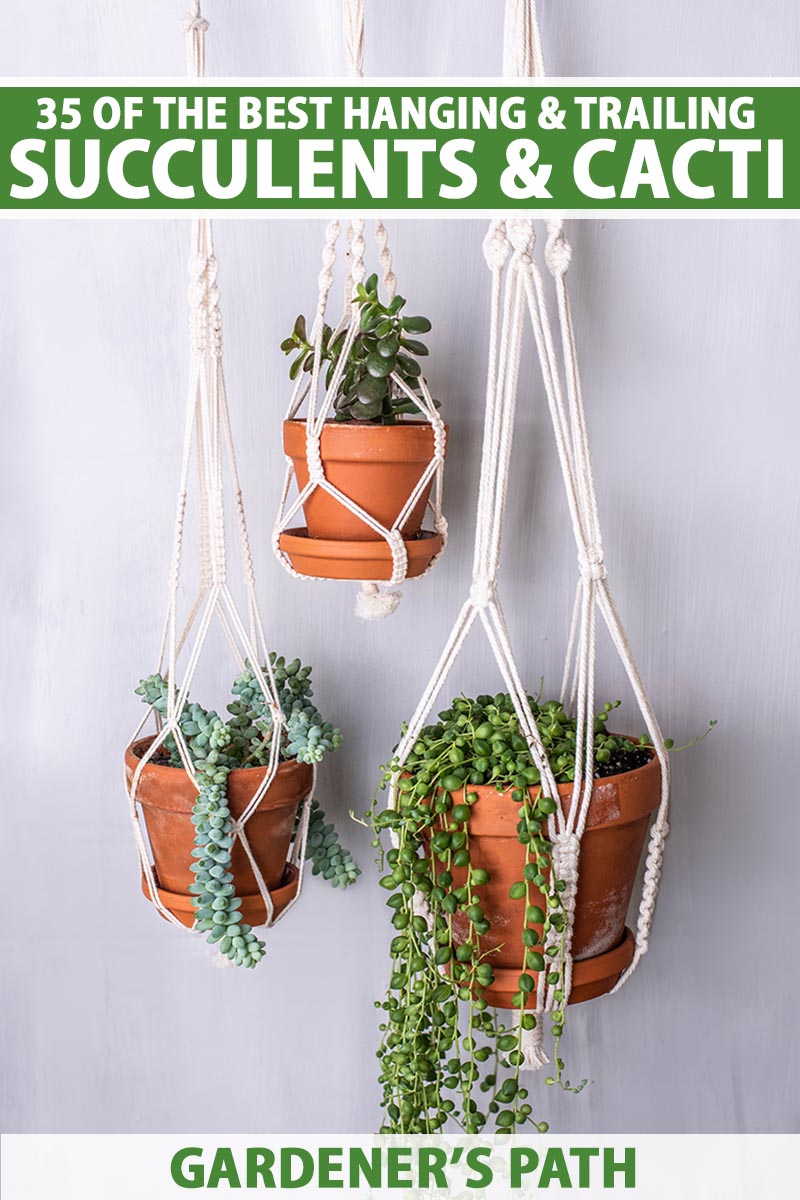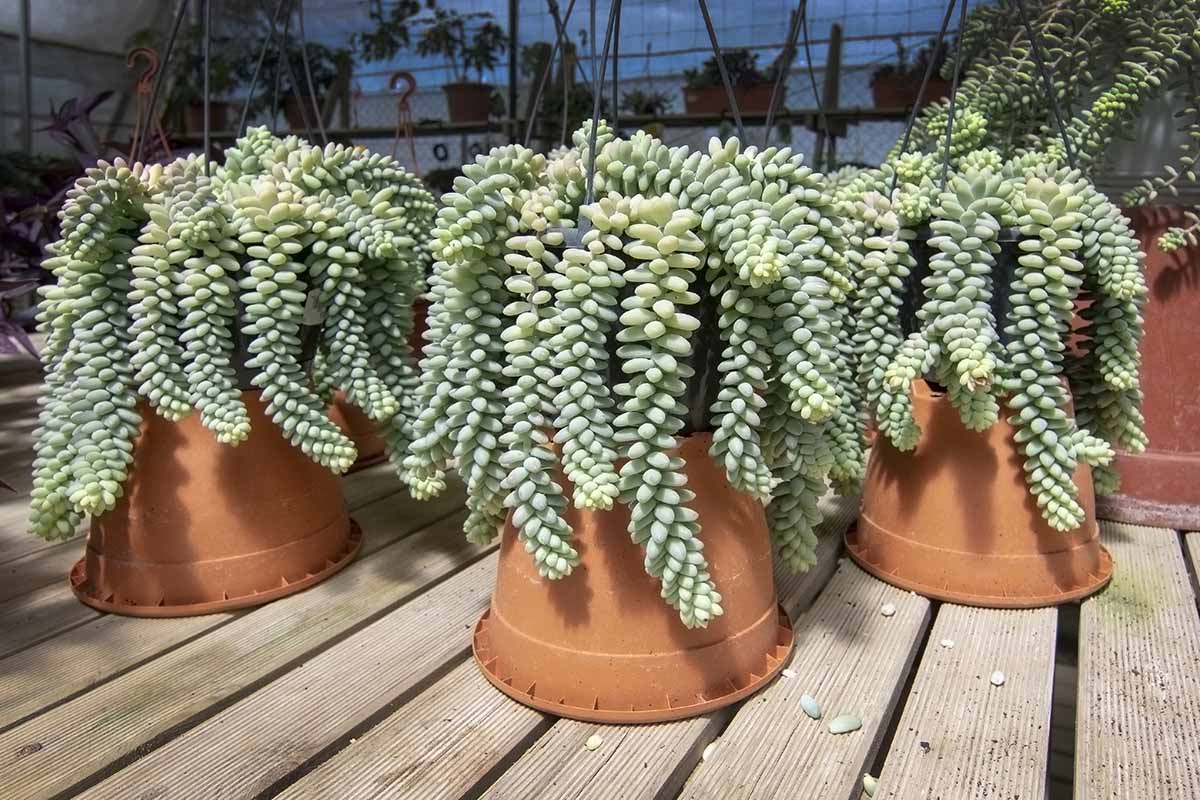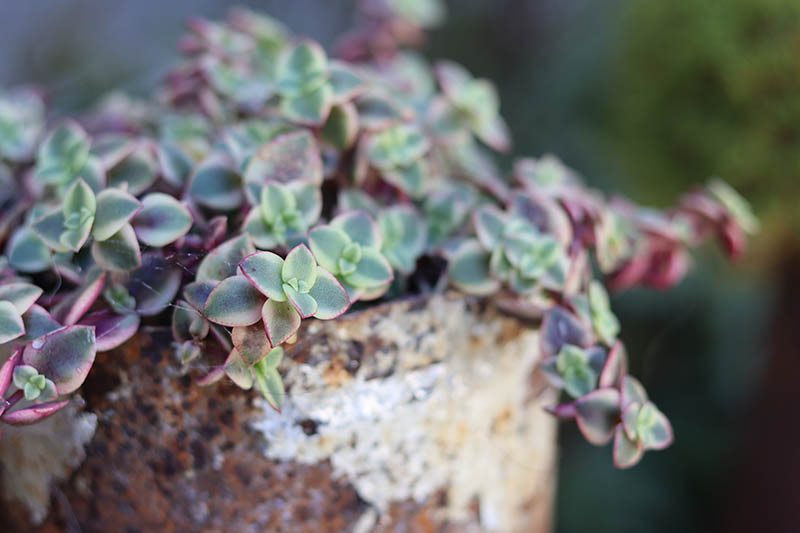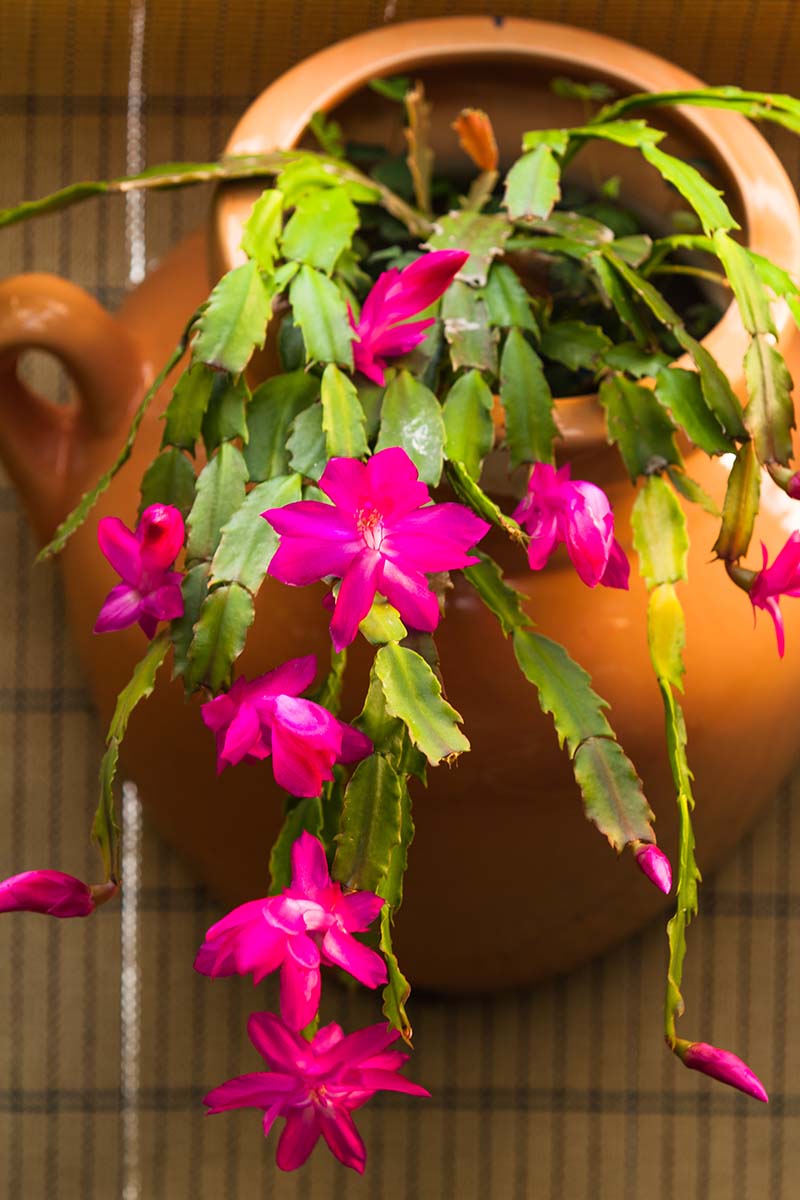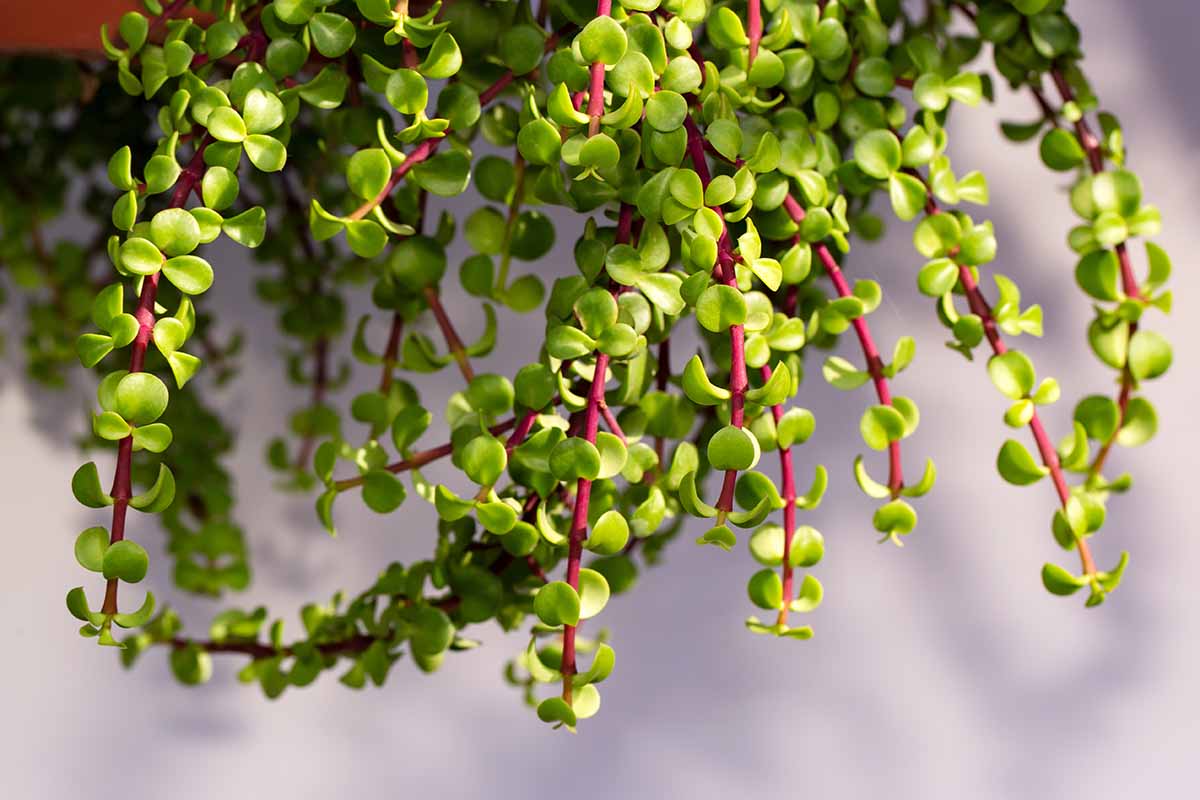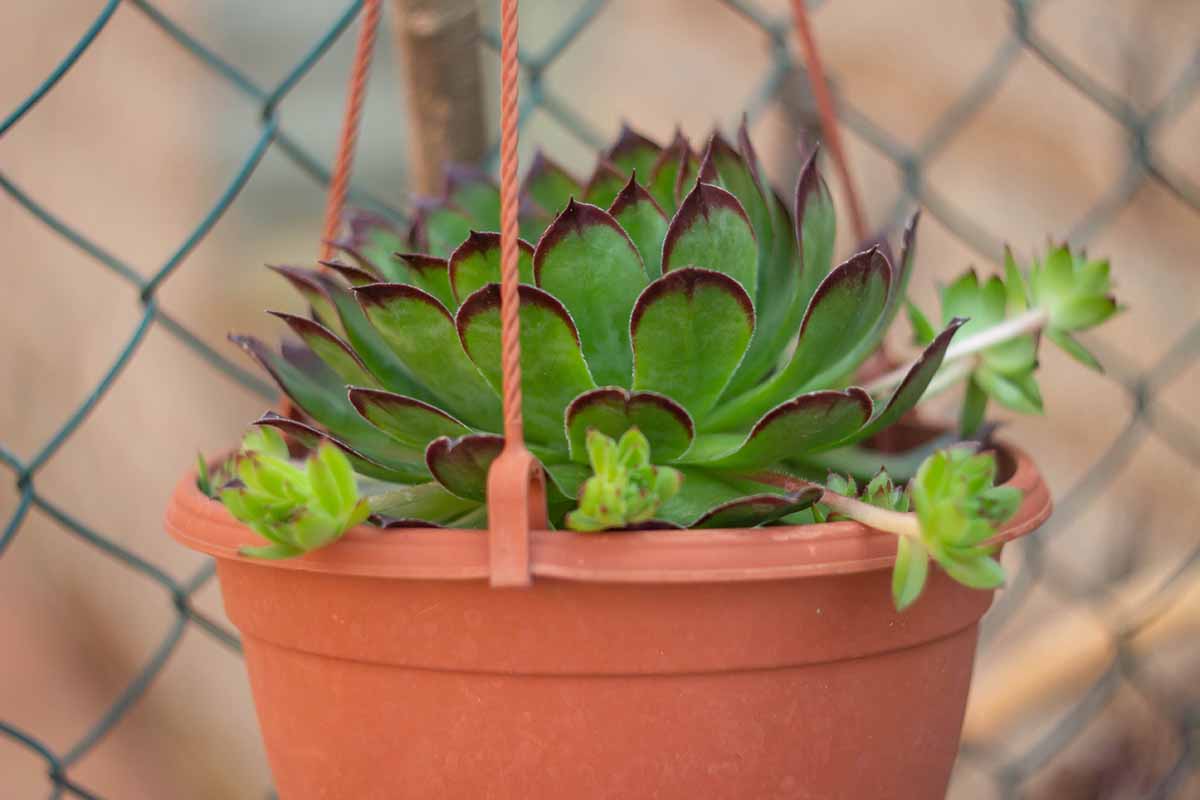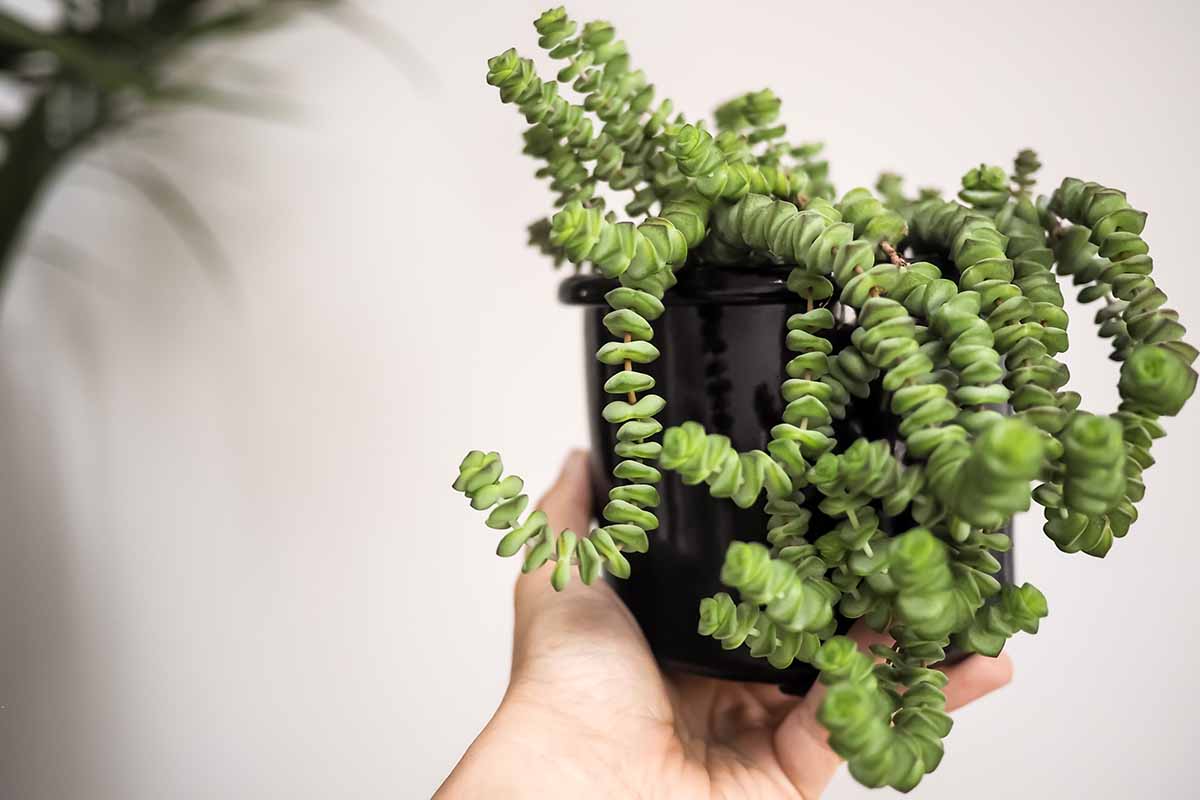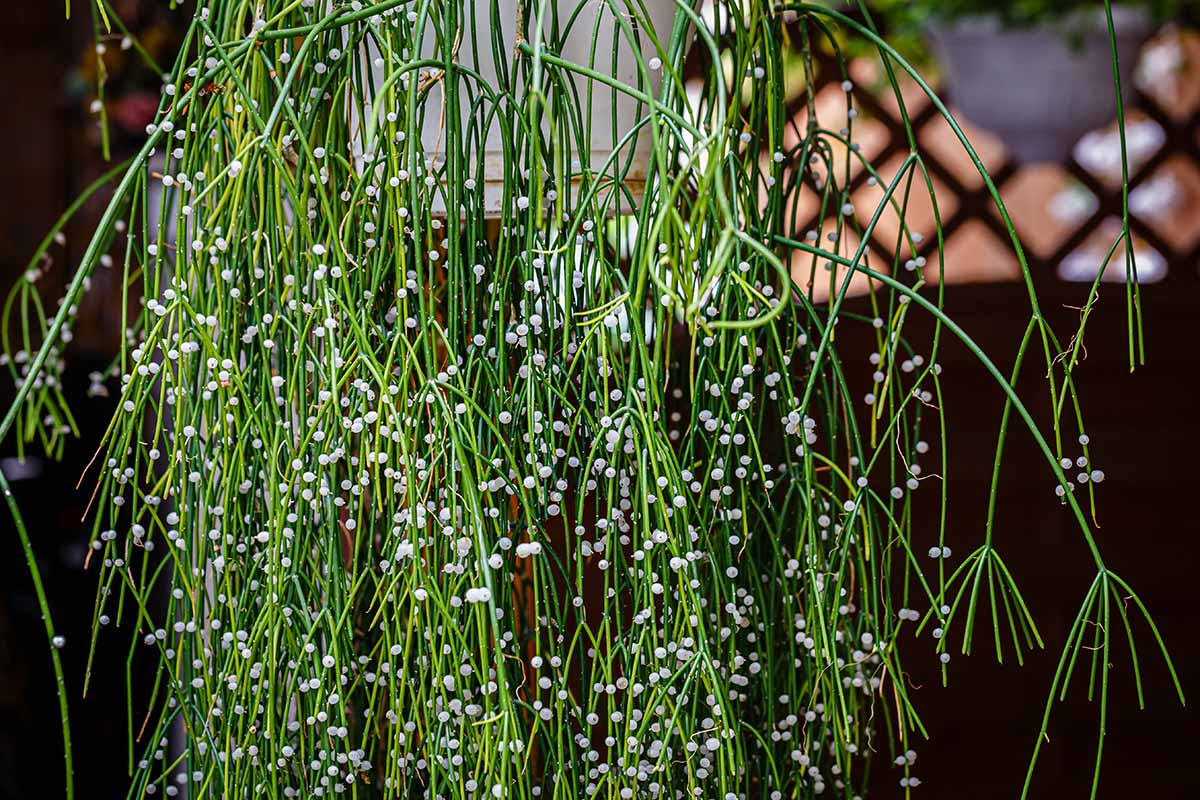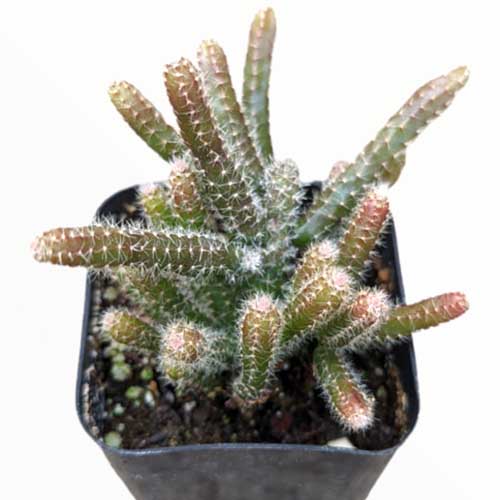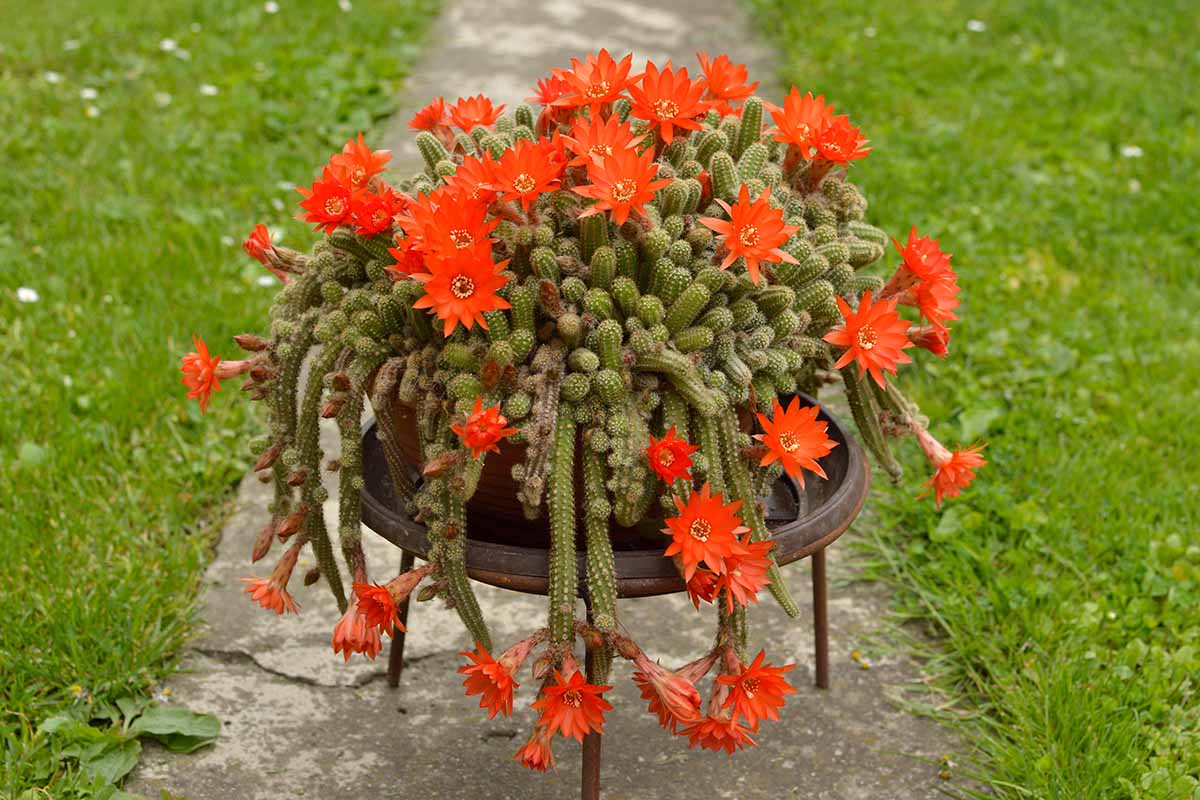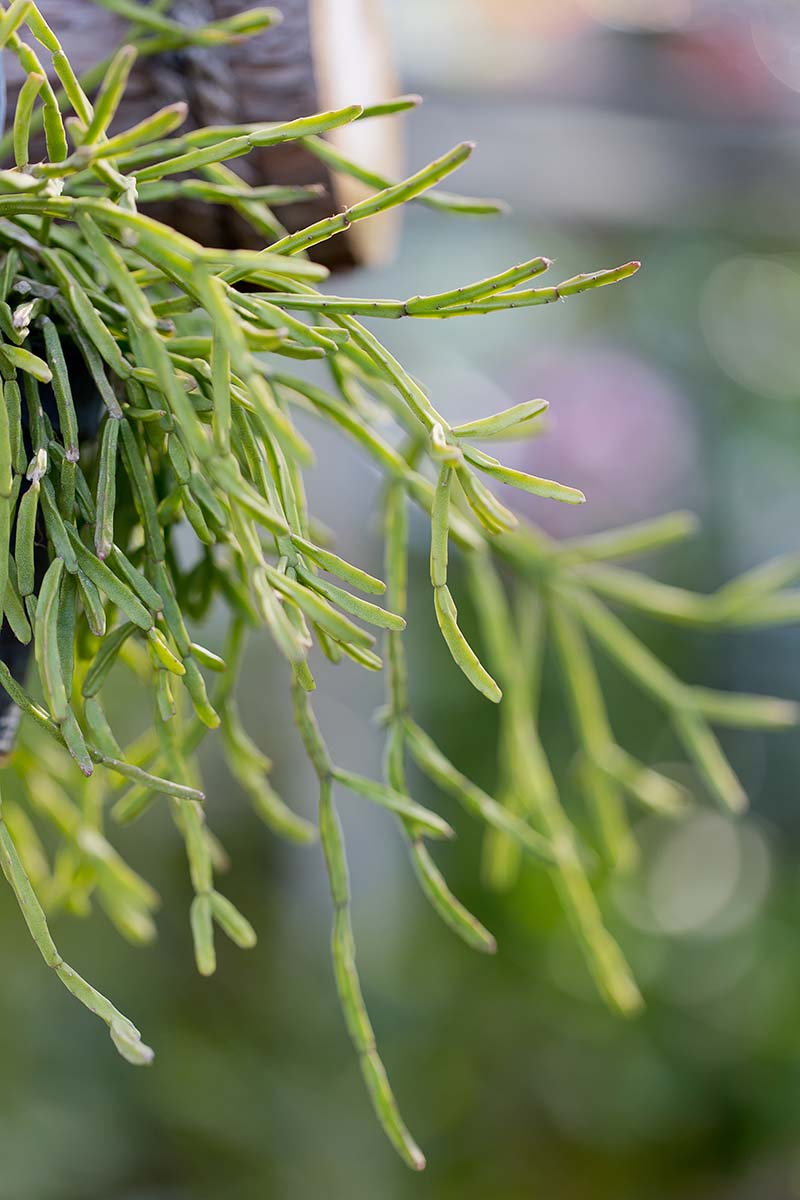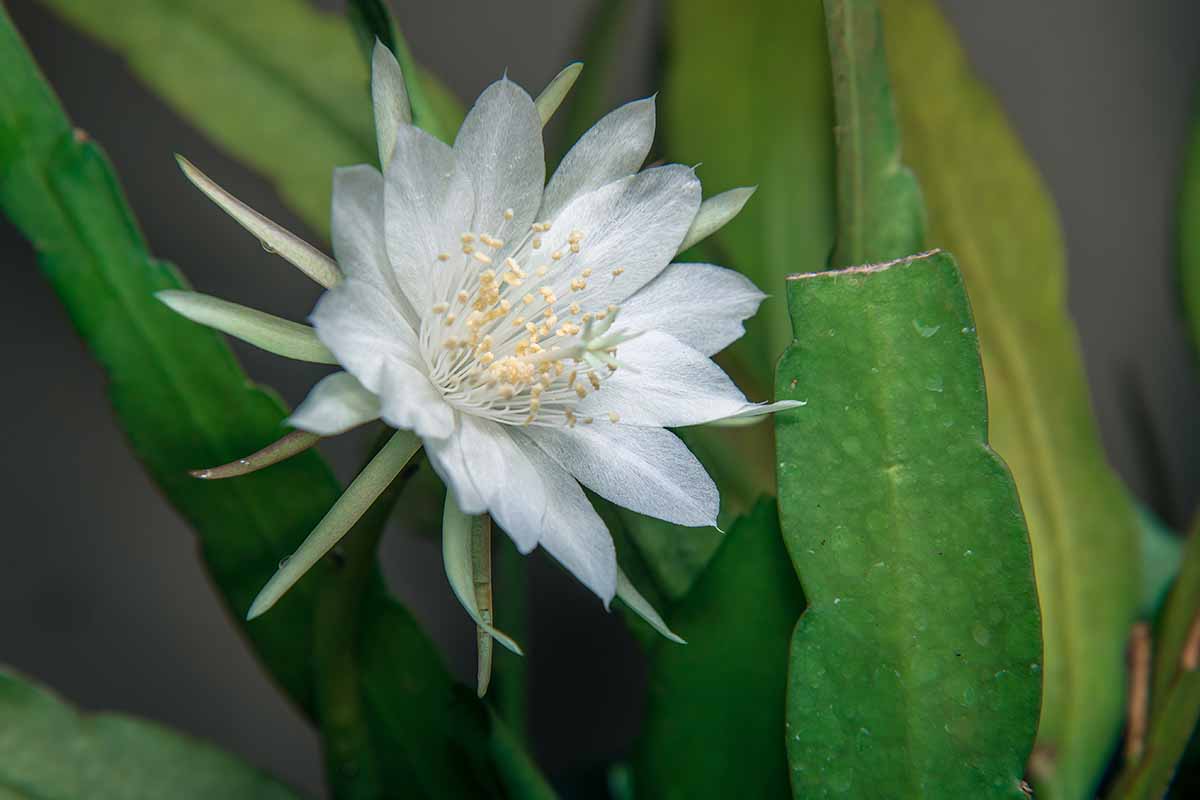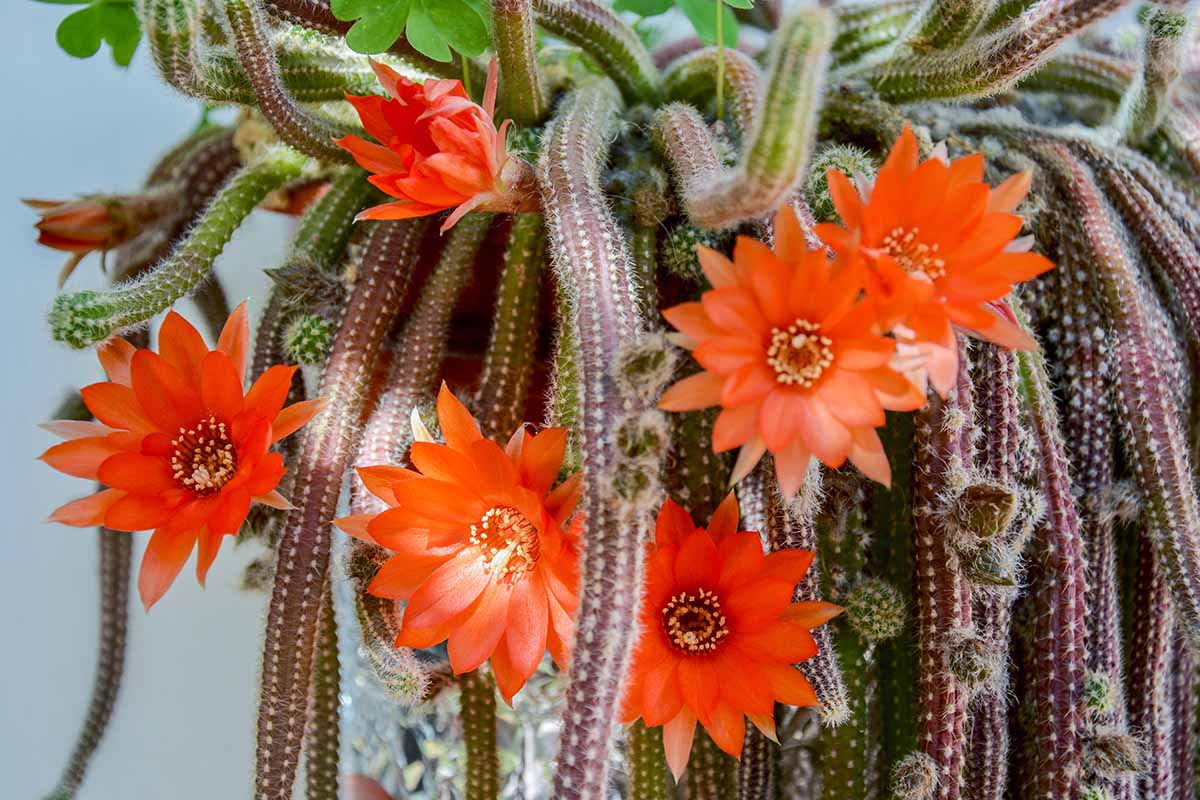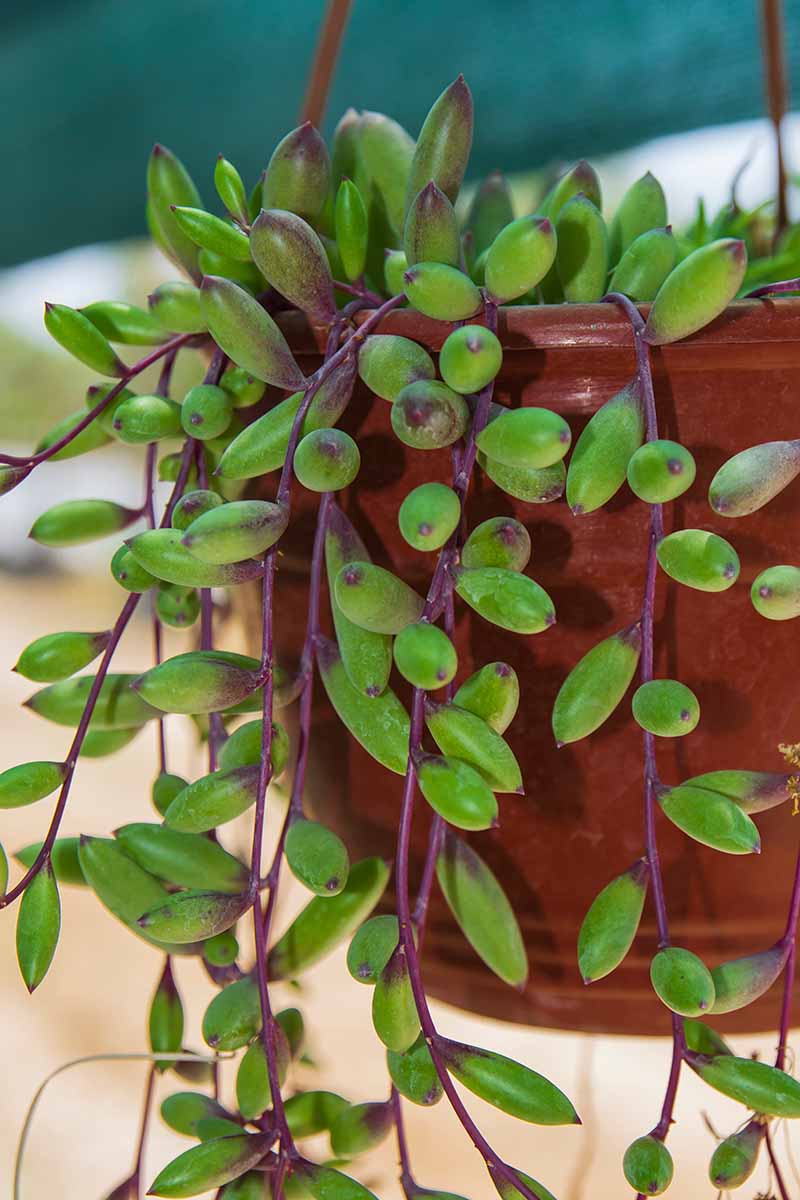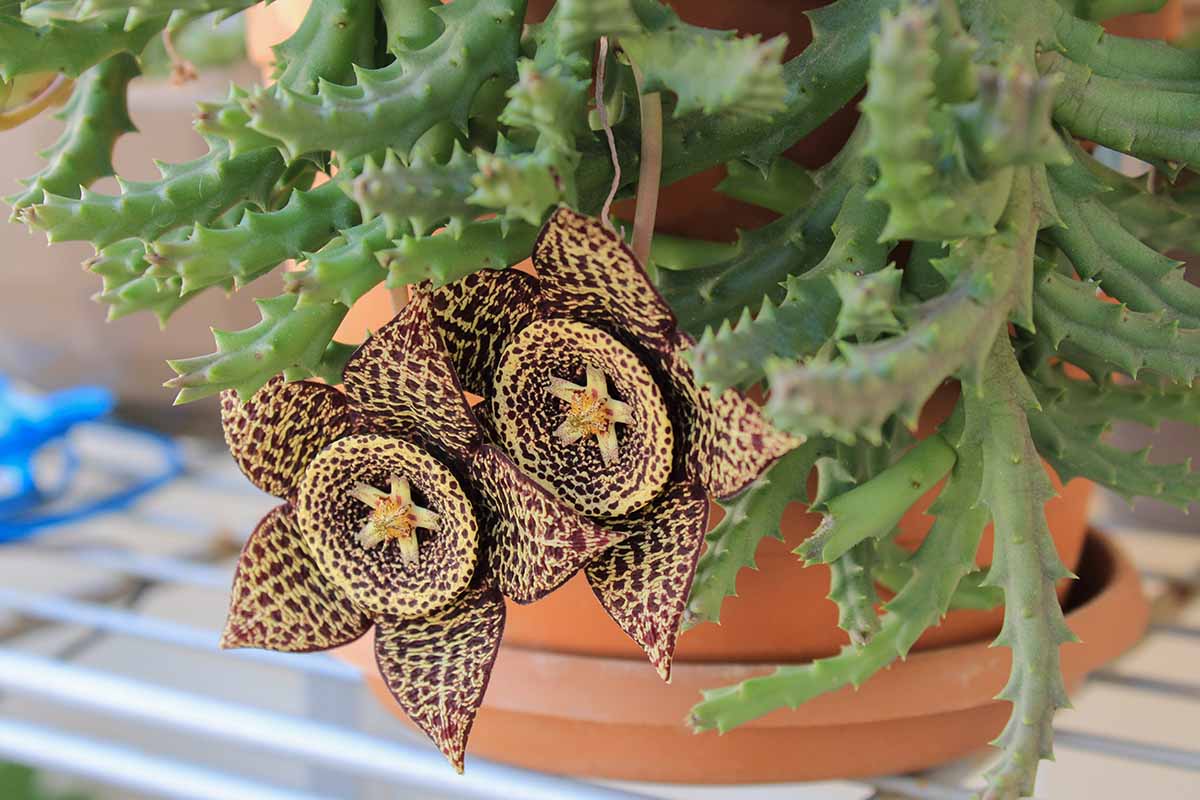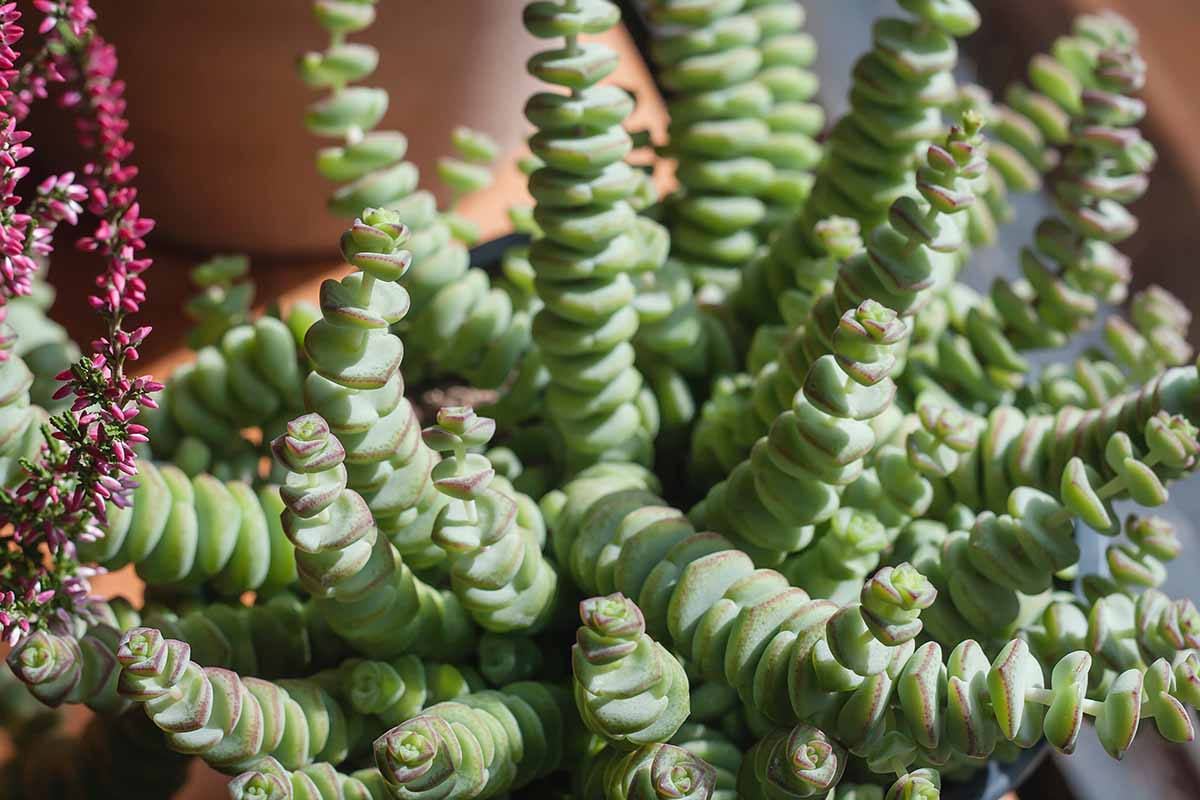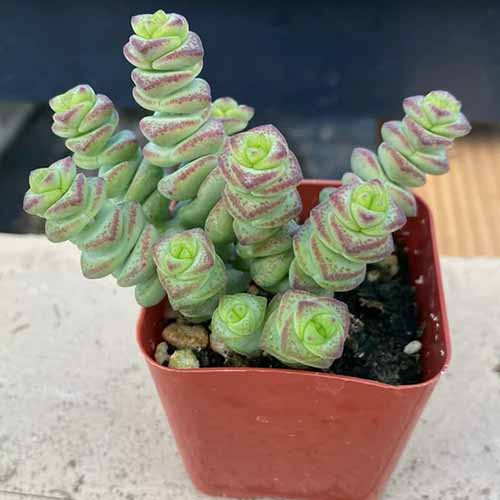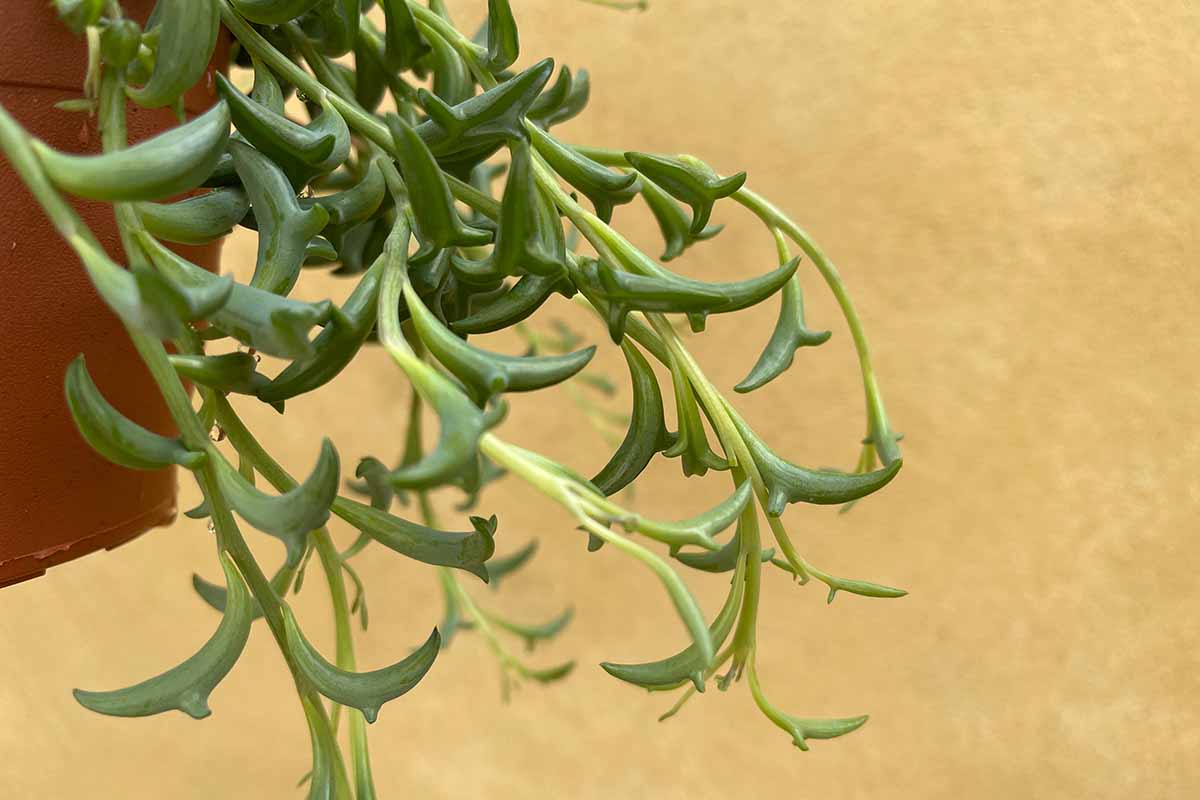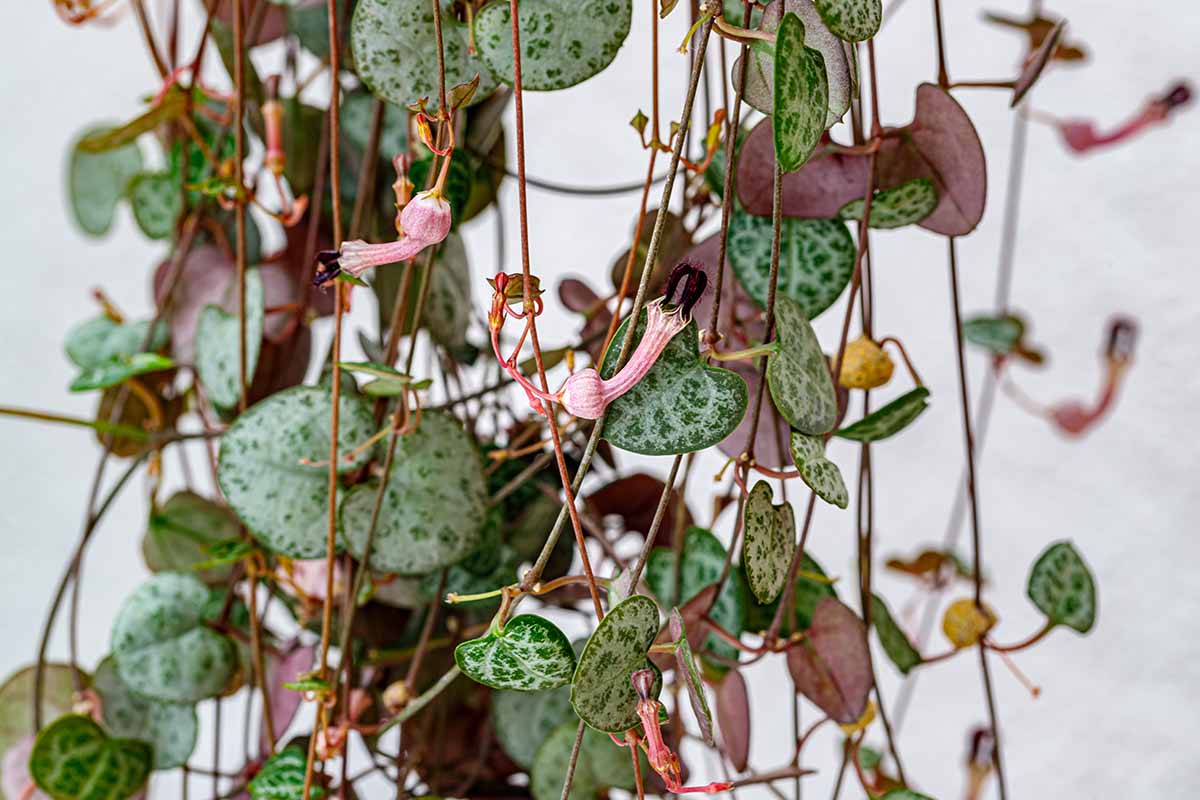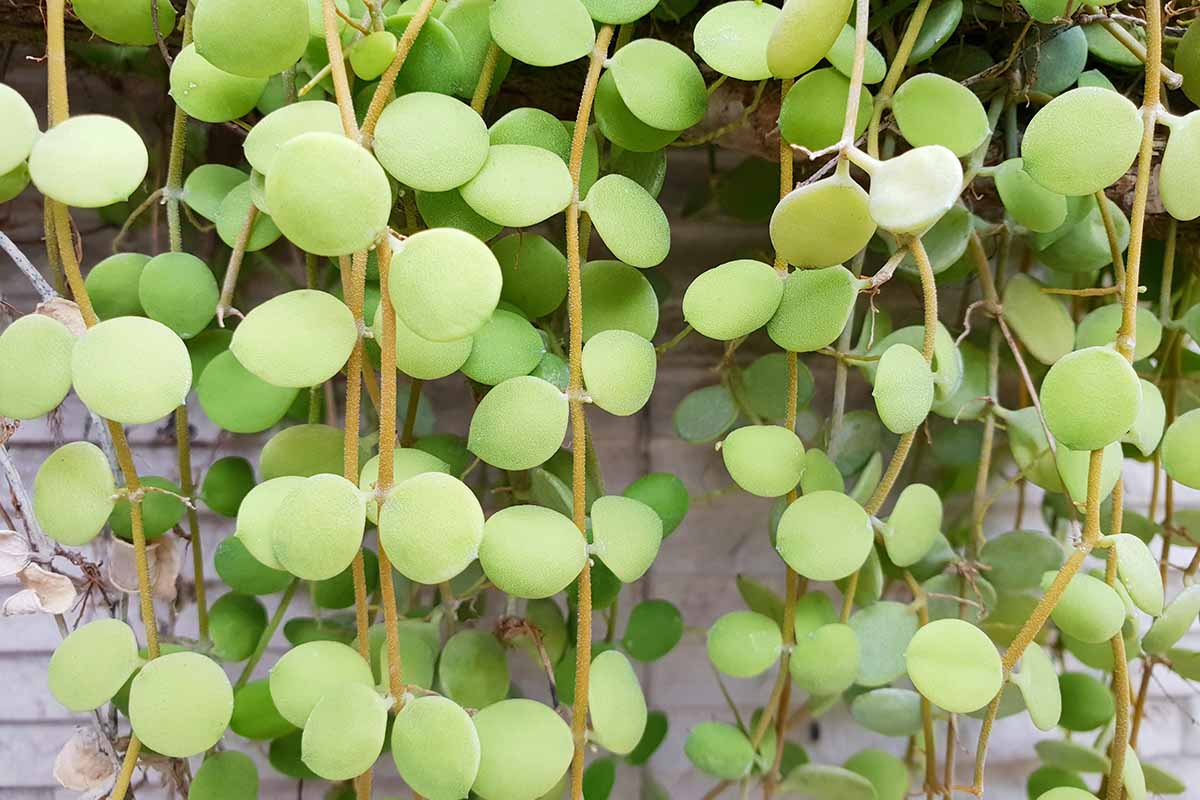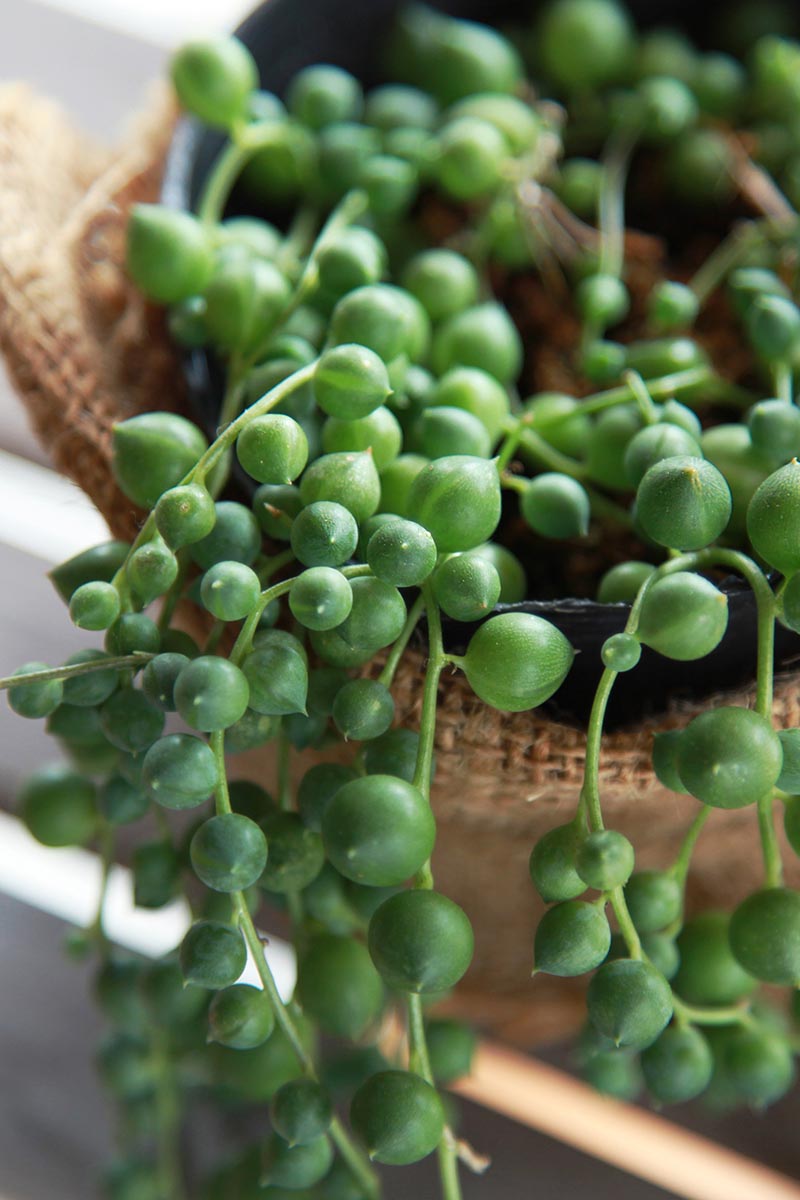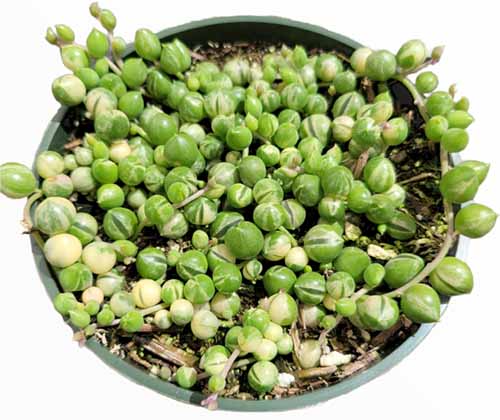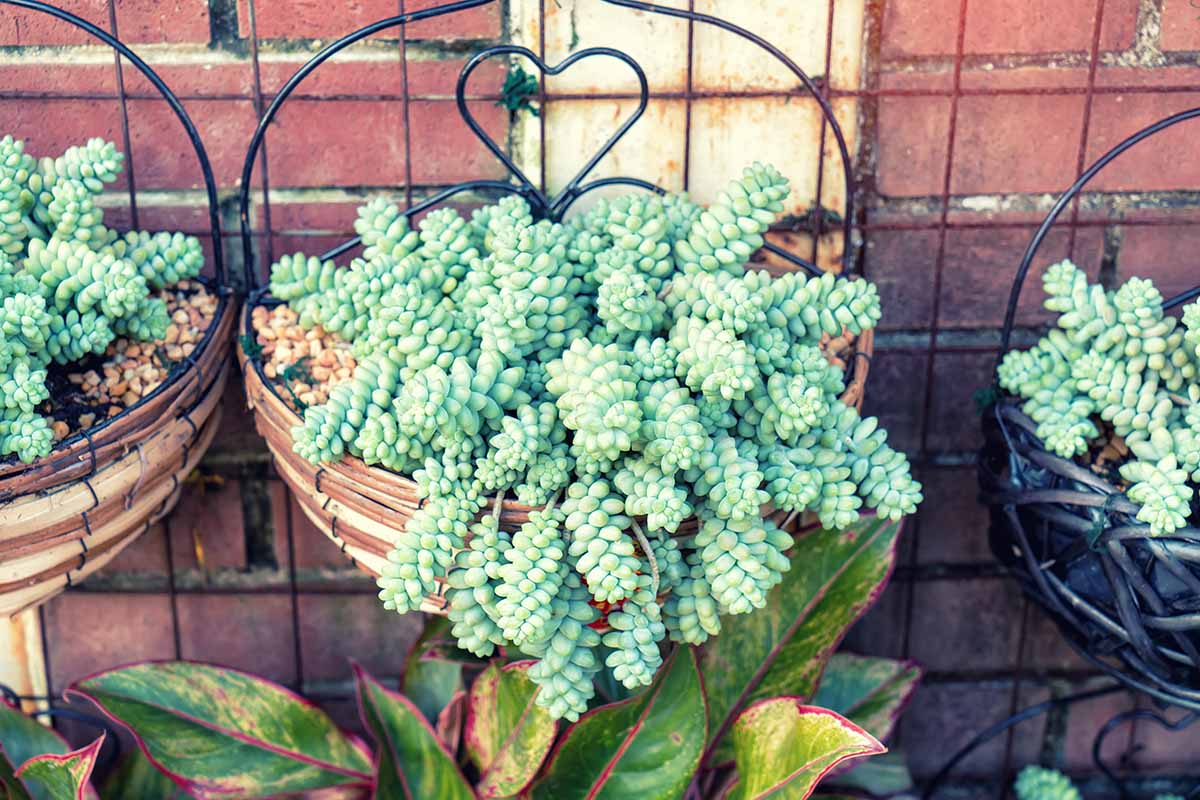The visual cue is clear – our cups are running over with delightful, succulent goodness. We link to vendors to help you find relevant products. If you buy from one of our links, we may earn a commission. We’re going to do a meet and greet with 35 different plants, sorting our way through vines of succulent leaves and columns of trailing cacti, until you find the plants you’re looking for. For each of these succulent or cacti selections, I’ll let you know what to expect in terms of foliage type, flowers, and size at maturity. I’ll also cover whether each option is safe for homes with pets or small kids when research is available on toxicity. And I’ll mention any spiny features you may want to be aware of. I’ll also provide information on any particular light or humidity needs you’ll want to know about, so you can make sure you have the growing conditions it takes to make these succulents and cacti happy. Finally, I’ll offer tips on where to find a specimen of your own – as well as USDA Hardiness Zones for those considering growing these selections outdoors year round. Ready to get on a first name basis with some sensational succulent candidates? Put on your name tag and take a quick glimpse at today’s participants: While many of these selections feature fabulous flowers, some of them are more likely to bloom indoors than others. You’ll learn more about flowering in the descriptions to come. Before we get started with the introductions, if you need to brush up on your succulent growing game, be sure to check out our guide!
1. Burro’s Tail
Burro’s tail is a member of the stonecrop family (Crassulaceae) that grows plump, rounded leaves along long, pendulous strands, which look like animals’ tails. The leaves of this succulent species, Sedum burrito, are bluish gray and tightly clustered along their stems. Strands usually reach one and a half feet long, but can grow longer if not disturbed. Leaves and stems can break off easily, as with many succulents, but broken off leaves are also easily propagated. Burro’s tail looks breathtaking in a hanging basket or trailing from a planter. Also known as “baby burro’s tail,” “baby donkey tail,” and my favorite, “troll necklace,” this succulent produces hot pink flowers on the ends of its stems. Some also call this plant “donkey’s tail,” but we’ll soon meet another plant, S. morganianum, that is more often known by that name. In fact, these two succulents are very similar, and sometimes burro’s tail is classified as a hybrid of S. morganianum. We’ll have a look at how to distinguish these two succulents with equine names a bit later in the article. The succulent stems of this species (Ceropegia haygarthii) feature flat, pale green leaves – and the real kicker, flowers that have to be seen to be believed. Indoors, place it near a south- or west-facing window. Outdoors, give it full sun but protect it from direct light at midday and in the late afternoon, as its foliage will scald. Burro’s tail is hardy outdoors in USDA Hardiness Zones 10 to 11, and is considered nontoxic. Live Burro’s Tail Sedum in 7-9” Pot No need for a stable for this burro – it will be content with a hanging basket. You can find a live burro’s tail specimen for purchase in a seven- to nine-inch pot from Terrain.
2. Calico Kitten
Calico kitten is a succulent that has a compact, mat-forming growth habit with trailing stems that can reach up to 12 inches long. Classified as Crassula pellucida ‘Variegata,’ this variety has heart-shaped leaves that are cream colored with green centers, and margins that are pink to maroon. Also classified as C. pellucida subsp. marginalis , bunches of white flowers form at the ends of succulent stems. Trailing from a planter or spilling from a hanging basket, calico kitten will be a delight. When caring for this succulent species indoors, bright indirect light is best, and some direct sun is fine as well. For outdoor specimens, calico kitten can be grown in full sun to part shade and can live outdoors year round in USDA Hardiness Zones 9 to 11. Calico kitten is tolerant of high humidity. If you have another type of kitten or cat in your home, one that likes to purr, keep this plant out of reach as it is potentially toxic, like other members of the Crassula genus. Live Calico Kitten in 2 or 4” Pot
3. Christmas Cactus
One of the floral staples of the winter holiday season, Christmas cacti are known for their showy and bright winter blooms. Various Schlumbergera species may be referred to as “Thanksgiving cacti,” “Easter cacti,” or “Christmas cacti,” depending on their different bloom times. And while the members of this genus are known broadly as “holiday cacti,” they are often all lumped together as “Christmas cacti.” Christmas cacti have flat, leafless, succulent, segmented stems that produce flowers in winter, with blooms in shades of red, pink, purple, yellow, orange, or white. Christmas cacti usually develop about a two-foot spread, but some older specimens can grow larger. Since the long stems of these cacti trail down, they work perfectly in hanging baskets. Caring for the nontoxic Christmas cactus is pretty easy. For starters, make sure to provide it with bright, indirect light when grown indoors. Outdoors, hang these cacti in part to full shade. For those in warmer climates, Christmas cactus can spend its time outdoors year round in USDA Hardiness Zones 10 to 12. Live Christmas Cactus in 8” Hanging Basket You can read more about caring for these winter-blooming cacti in our complete guide to growing Christmas cactus.
4. Cliff Cotyledon
Cliff cotyledon is a gorgeous succulent that has fuzzy, egg-shaped leaves that are light grayish-green in color, often sporting reddish tips and leaf margins. Also known as “little cliff bells,” Cotyledon pendens bears fabulously showy, pink to red bell-shaped flowers that hang down from the ends of its stems. This succulent species is closely related to another succulent you may have heard of called “bear’s paw.” Cliff cotyledons are small, mat-forming shrubs with drooping stems, reaching about two feet long at maturity. This plant is gorgeous with its stems and bell-shaped flowers flowing from a hanging basket or trailing from a planter. Outdoors, cliff cotyledon can grow in full sun to part shade. Indoors it will thrive in indirect bright light, though direct sun is fine too. For those who wish to grow this lovely plant outdoors year round, it’s hardy in USDA Hardiness Zones 10 to 11. Let this species dry out between waterings, and use the bottom watering method. Since other species of the same genus are toxic, this species may not be safe for homes with small children or pets. Live Cliff Cotyledon in 4” Pot Is Cliff your guy? (I told you we’d be getting on a first name basis, didn’t I?) You can purchase a live cliff cotyledon plant in a four-inch pot from the Next Gardener via Walmart.
5. Coral Cactus
Named for its resemblance to certain types of coral, coral cactus (Rhipsalis cereuscula) is an epiphyte that has slender, branching stems. Members of the Rhipsalis genus are also known as “mistletoe cacti,” named for the whitish fruits that develop on the plants, resembling mistletoe berries. Also known as “rice cactus,” this species bears creamy white flowers at the end of cylindrical, pale green jointed stems that arch as they grow longer. These cacti have a shrubby growth habit, growing up to two feet tall and wide, with small, bristle-like spines. R. cereuscula will trail beautifully from a hanging basket. Coral cactus is an easy-care houseplant that is quite tolerant of neglect. This cactus needs a bit more soil moisture than its desert relatives – use an orchid potting medium rather than a pre-mixed medium designed for cacti. It also likes high humidity, and medium to bright, indirect light. As a member of the Rhipsalis genus, this species may be nontoxic, and is hardy in USDA Hardiness Zone 10. Live Coral Cactus in 2”, 4”, or 8” Pot If you think this epiphytic cactus is simply epic, you’ll find a coral cacti available for purchase in two-, four-, or eight-inch pots from the Succulents Depot via Walmart.
6. Dancing Bones
Dancing bones (Hatiora salicornioides) is another branching, jointed cactus with a bushy growth habit. This cactus’s arching or pendant stems are light green and bear small, bell-shaped flowers that are orange to yellow. Also called “drunkard’s dream,” “spice cactus,” and “bottle cactus,” the spineless stems of this epiphytic or lithophytic cactus species can grow up to two feet long, making it a perfect selection for a hanging basket. Dancing bones will thrive indoors with indirect, bright light. Outdoors, locate it in part shade. This species is hardy in Zones 9b to 11. Other members of the Hatiora genus are toxic, so it would be wise to keep this species out of reach of kids and pets. Live Dancing Bones Cactus in 2”, 4”, or 6” Pot Do you hear that music? The beat goes on. You can find dancing bones plants in two-, four-, or six-inch pots from the Succulents Depot via Walmart.
7. Donkey’s Tail
Donkey’s tail is a succulent that produces long stems covered with fleshy, crescent-shaped, light green to bluish-gray leaves. Classified botanically as Sedum morganianum, donkey’s tail is similar to burro’s tail – our first selection in this article – but its leaves are pointy rather than rounded, and they are more spaced out along their stems than those of burro’s tail. Despite their differences, some sources consider burro’s tail to be a hybrid of S. morganianum rather than a separate species. Also sometimes called “horse’s tail” or “lamb’s tail,” donkey’s tail produces trailing, succulent stems that can grow up to four feet long, with clusters of small, pink to red flowers appearing at the ends of stems. The long trailing vines of donkey’s tail are a knockout in a hanging basket. Donkey’s tail is considered nontoxic and will thrive as a houseplant with indirect, bright light, although some direct sun is fine too. For those who’d like to grow this sedum outdoors, donkey’s tail can be grown in full sun to partial shade. Indoors or out, as temperatures rise, provide less exposure to direct sunlight. Donkey’s tail can be successfully overwintered in USDA Hardiness Zones 10b to 11a. Live Donkey’s Tail Sedum in 4” Pot Make up your own version of pin the tail on the donkey – you can find a live donkey’s tail sedum in a two-, four-, six- or eight-inch pot via Walmart. Read more on how to grow and care for Donkey’s tail here.
8. Elephant Bush
Elephant bush is a bushy, trailing succulent with small, fleshy leaves. This species, Portulacaria afra, bears rounded, medium to light green foliage on purplish-red stems and produces clusters of tiny, pink flowers. Elephant bush looks similar to the widely known houseplant, jade (Crassula ovata), but it is not related to this member of the Crassula genus. It is also known by the common names “dwarf jade,” “miniature jade” or “small leaf jade.” In hanging baskets, elephant bush will create a lovely display of bushy, trailing foliage. As a houseplant, elephant bush will thrive with direct sun, bright indirect light, or medium indirect light. Outdoors, grow it in full sun to partial shade, and bring it in for the winter unless you live in USDA Hardiness Zones 9b to 11. Also known as “elephant food,” “elephant plant,” and “porkbush,” this plant is nontoxic, making it a safer succulent alternative to crassula jade for households with pets or small kids. Live Elephant Bush in 2”, 4”, or 6” Pot How about a different type of elephant in the room? You can find a live elephant bush plant in a two-, four-, or six-inch pot from the Succulents Depot via Walmart. Find tips on growing elephant bush here.
9. Fishbone Cactus
Fishbone cactus (Disocactus anguliger) is an epiphytic plant that has strap-shaped, flattened, and leafless stems that look like zigzags. These jungle cacti are known for their large, showy, white and yellow flowers. Formerly classified as Epiphyllum anguliger, this species is also known as “zigzag cactus,” or “rickrack cactus” for its rickrack ribbon-shaped leaves. Small specimens start with upright stems, but as stems grow longer, they eventually take on a pendant growth habit with each stem potentially growing several feet long, making fishbone cactus a first-rate option for hanging baskets. As a houseplant, fishbone cactus will thrive with medium to bright, indirect light – avoid direct sun. Outdoors, place this species in part shade – it can overwinter outdoors in USDA Hardiness Zones 10b to 11b. This cactus is considered nontoxic. In fact, it produces edible fruit similar to the pitaya, the fruit of one of its close relatives. If you’re thinking all this sounds great, but things seem a bit different from the fishbone cactus you are familiar with – different flower color, different light needs – I’m now going to throw a wrench into the works and let you know that there are at least two very similar-looking cacti species that go by the common name “fishbone cactus.” The other fishbone cactus is botanically classified as Selenicereus anthonyanus. These two species can be very difficult to tell apart, but unfortunately, their care needs differ. Live Fishbone Cactus in 2”, 4”, or 6” Pot You can learn more about this cactus identity crisis and find more tips for growing fishbone cactus in our article. (coming soon!)
10. Hens and Chicks
“Hens and chicks” is a common name given to many members of the Crassulaceae family, but one of the most well-known species to take this name is Sempervivum tectorum, also known as the common houseleek. S. tectorum grows in lovely rosettes with pale green or greenish-gray leaves that often have reddish-purple tips. Flower stalks rise up from the rosettes, producing reddish-purple blooms. This mat-forming succulent produces smaller offsets (the “chicks”) from a central rosette (the “hen”). Offsets can spill over the sides of pots or the edges of hanging baskets, creating a lovely trailing effect. This succulent prefers full sun, and it can be grown indoors as well as outdoors if adequate light is available. These plants can survive outdoor conditions year-round in USDA Hardiness Zones 3 to 8. S. tectorum is considered nontoxic, making it safe for households with pets and small kids, as well as for a children’s garden. This succulent species won the RHS Award of Garden Merit in 1993. Hens and Chicks in 4” Pot Hens and chicks are succulents that send a super sweet maternal message. You’ll find a four-inch live hens and chicks plant available for purchase from JM Bamboo via Walmart. Learn more about growing these cute succulents in our guide to growing hens and chicks.
11. Ice Plant
Many different succulent plants go by the common name “ice plant” but most of these are grown more often as garden annuals or perennials rather than houseplants. The ice plant we’re recommending here is classified botanically as Corpuscularia lehmannii and you won’t find it in the average flower bed. A member of the Aizoaceae or fig marigold family which includes lithops, C. lehmannii has chunky, wedge-shaped leaves that are green to bluish-gray, with bright yellow blooms that resemble strawflowers. Ice plant has sprawling, succulent stems with a spreading growth habit, reaching eight inches tall and 12 inches wide. Used in a hanging basket, ice plant’s chunky stems will create a funky visual vibe. This succulent is easy to care for and is a moderately fast grower. It will thrive in direct sunlight to bright, indirect light, and is hardy in Zones 9 to 11. Most sources consider this plant to be nontoxic like other members of the fig marigold family. Live Ice Plant in 2” or 4” Pot
12. Jade Necklace
Jade necklace (Crassula rupestris subsp. marnieriana) has trailing stems with leaves packed close together, giving them the appearance of chunky strands of gemstones. This succulent is a subspecies of C. rupestris that is also sometimes called “Chinese pagoda.” The leaves of jade necklace are rounded to squarish and are light green with red margins, taking on a purple hue in direct sun. Flowers appear at the ends of stems and are cream to pink in color. The trailing, succulent stems of jade necklace reach six to 12 inches long and will spill nicely out of a hanging basket. They cascade down and then rise up, creating a snakelike appearance that no doubt inspired one of the plant’s other common names, “worm plant.” This slow-growing Crassula is easy to care for. For indoor plants, provide bright, indirect light to a few hours of direct sun. Outdoors, avoid too much direct sun, especially in the heat of the day, and overwinter indoors unless you are in USDA Hardiness Zones 9b to 11b. As many species in the Crassula genus are toxic, this succulent is likely best kept out of reach of pets and small children. Live Jade Necklace
13. Jelly Bean Plant
Jelly bean plant is a type of succulent whose small, glossy green leaves grow on stems that trail downward before turning upright. Classified as Sedum x rubrotinctum or S. rubrotinctum, the small, rounded, bean shaped leaves of this plant will take on a pink to red tint when stressed by sun or drought. Also known as “Christmas cheer” and “pork and beans,” this succulent bears yellow, star-shaped flowers. The colorful clusters of this sedum’s foliage tumble nicely over the edges of hanging baskets. Jelly bean plant will thrive with full sun to bright, indirect light. Bring plants indoors for the winter unless you are gardening in USDA Hardiness Zones 9a to 11a. While many sedum species are considered nontoxic, S. rubrotinctum may cause skin irritation with skin contact, as well as stomach irritation if ingested. Jelly bean plant won the Royal Horticultural Society’s Award of Garden Merit in 2012. Live Jelly Bean Sedum in 2” or 4”Pot
14. Lantern Flower
Lantern flower is quite unique among our selections. This member of the dogbane family (Apocynaceae) has thick, fleshy, bluish-green stems, which have a trailing, climbing, and vining growth habit and can reach several feet in length, making this selection an excellent choice for a hanging basket. As its common name suggests, these flowers, white or cream-speckled with burgundy, may be described as looking like lanterns. But I would suggest, perhaps it would be more apt to describe them as lanterns designed by extraterrestrials. Or rather, extraterrestrial lanterns that are secretly ray guns. C. haygarthii has many other common names, including “wine-glass vine,” “parasol flower,” “bushman’s pipe,” and “snake creeper.” And its latest nickname, coined here by me, “Martian ray gun flower.” (Yes, I may have watched too many episodes of “The Twilight Zone” throughout my life.) Whatever its mind-boggling blooms look like to you, this unusual succulent species is easy to care for. When grown as a houseplant, C. haygarthii will thrive with medium to bright indirect light. Outdoor specimens should be grown in part shade to shade, with more shade for locations with the hottest climates and weather. C. haygarthii is hardy in USDA Hardiness Zones 10 to 11. This succulent prefers a potting medium that is rich but well-draining, and regular watering during the growing season – avoid letting plants dry out between waterings. However, a month-long, dry dormancy period is also recommended in late winter.
15. Medusa’s Head
Medusa’s head is a type of Euphorbia, a genus which includes both gopher flowers and poinsettias. This succulent looks as you would imagine, based on its Greek myth-inspired common name – it has a central “head” with stems radiating out from it like snakes. Classified as Euphorbia caput-medusae (syn. E. flanaganii), its succulent stems reach up to two and a half feet long and are bluish-green with scales, producing yellow flowers at their ends. These snakelike stems are perfect for streaming out over the sides of hanging baskets. Also known as “green crown” and “jellyfish head euphorbia,” this species can grow in full sun or bright, indirect light. Outdoors, it is hardy in Zones 9 to 12. Euphorbias contains sap that can cause contact dermatitis so handle medusa’s head with gloves – and it may be toxic, so keep this plant out of reach of kids and curious pets. Want to learn more about growing this myth-inspired succulent? Read our article on growing and caring for a Medusa’s head euphorbia. (coming soon!)
16. Million Hearts
Million hearts (Dischidia ruscifolia) is an epiphytic vine that has very small, heart-shaped, succulent leaves growing on long, trailing stems that can reach six feet in length. Also called “million hearts vine,” like the lantern flower described above, this succulent species is a member of the dogbane family and related to wildflowers such as milkweed. The leaves of million hearts are green to grayish-green, and will take on a reddish hue when exposed to direct sun. Formerly classified as Sedum sieboldii, October daphne reaches nine inches tall with a 24-inch spread, and is also commonly called “October stonecrop,” “Siebold’s stonecrop,” and “Siebold’s sedum.” Million hearts is easy to grow. Provide it with bright, indirect light indoors. Outdoors, it’s best kept in part shade and can overwinter in USDA Hardiness Zones 10 to 12. Plants should be allowed to dry out between waterings; however, this species likes higher humidity and requires more moisture than many succulents. Use a water-retentive but airy potting medium for million hearts, such as an orchid mix whose ingredients include chunky coconut husks. Like many other members of the dogbane family, this species is potentially toxic if ingested, so keep it out of reach of vulnerable members of your household. Live Million Hearts Vine in 3” Pot The countless, tiny hearts on this plant might serve as good reminders of the many small wonders in life to be grateful for.
17. Mistletoe Cactus
Mistletoe cactus is related to and has a similar growth habit as coral cactus, mentioned above, but this epiphytic species can mature to a much larger size. Classified as Rhipsalis baccifera, this leafless cactus species has narrow, branching stems that can reach a whopping 13 feet long. Stems are green, turning red with sun and heat stress. Flowers are creamy white in color, giving way to white fruits that look like mistletoe berries, inspiring this plant’s most often used common name. Other nicknames include “mouse tail,” “currant cactus,” and “spaghetti cactus.” Previously classified as R. parasitica or R. cassutha, which are now considered synonyms, bristles on this cactus species are usually only found on young specimens. In hanging baskets or elevated pots, the long, trailing stems of this Rhipsalis will make quite a visual impact. Mistletoe cactus thrives with part shade or bright indirect light, tolerates humidity well, and is considered nontoxic. Unless you live in USDA Hardiness Zones 9b to 11, be sure to overwinter specimens indoors. Live Mistletoe Cactus in 2”, 4”, 6”, or 8” Pot Need an excuse for smooching with your sweetie? You can leave this mistletoe hanging in your home all year long. You’ll find a live mistletoe cactus for purchase in a two-, four-, six-, or eight-inch pot from the Succulents Depot via Walmart.
18. Monkey’s Tail
Monkey’s tail is a cactus that has drooping, cylindrical stems covered with golden to brown spines. Known botanically as Cleistocactus winteri subsp. colademono, this plant’s trailing stems reach about two and a half inches wide and can grow to be eight feet long or more. As plants mature, they grow long, white, hair-like spines, giving the stems a furry appearance. Monkey’s tail cactus, previously classified as Hildewintera colademononis, bears showy flowers that are orange to red with pink centers. Additional common names for this plant include “golden rat tail,” “gold-spined hildewintera” and “gold-spined winterocereus.” The trailing growth habit of this species makes it perfect for displaying in a hanging basket. Monkey’s tail is a fast-growing plant that does best in bright to medium, indirect light, and can overwinter outdoors in USDA Hardiness Zones 10 to 12. Grow specimens in a well-draining potting medium designed for cacti, and allow it to dry out between waterings. 5” Unrooted Live Monkey’s Tail Cactus Cuttings
19. October Daphne
October daphne (Hylotelephium sieboldii) is a succulent that has a creeping, trailing growth habit. Blue-green leaves are oval or fan shaped, turning red or purple in fall. Stems produce leaves in whorls of three, and bear clusters of pink flowers at their ends. October daphne will spill its foliage gloriously over the rims of hanging baskets or planters. This succulent can be grown indoors in direct sun to indirect, bright light. Outdoor specimens will thrive in full sun to light shade – some shade is especially welcome in hotter climates and weather. October daphne is hardy in USDA Hardiness Zones 3 to 9. When growing this succulent outdoors in the colder parts of this hardiness range, October daphne will die back during winter and produce new growth in the spring.
20. Peanut Cactus
Peanut cactus (Chamaecereus silvestrii syn. Echinopsis chamaecereus) bears some resemblance to monkey’s tail, discussed above, but it’s not as hairy looking. This mat-forming species has green, peanut-shaped stems and offsets. Stems are ribbed, and lined with short, white bristles. As the stems mature, they trail and bear showy red-orange flowers. This plant will be happiest when provided with full sun, where it will flower effortlessly. Outdoors, this species is hardy in USDA Hardiness Zones 9 to 11. Peanut cactus received the Royal Horticultural Society Award of Garden Merit in 2002. Live Peanut Cactus Handle these prickly peanuts with care. Live C. silvestrii peanut cacti are available for purchase in two-, four-, or six-inch pots from the Succulents Depot via Walmart.
21. Pencil Cactus
Pencil cactus is a member of the Euphorbia genus, like Medusa’s head, described above. This species (E. tirucalli) has thin, green, branching stems, which will create a delicate, wispy mass of foliage in hanging baskets, accompanied by small, inconspicuous yellow flowers. However, growing in the wild, this euphorbia can attain the proportions of a small tree. Pencil cactus is known by a bevy of other common names, including “Indian tree spurge,” “milkbush,” “pencil euphorbia,” “African milk bush,” “firestick plant,” and “finger tree.” Pencil cactus is easy to care for. Indoors, provide it with bright, indirect light and some direct sun, if possible. Outdoors it is hardy in Zones 10 to 12, and can be grown in full sun to part shade. However, be aware that when grown in contact with the ground, E. tirucalli will naturalize easily outdoors within this range and has the potential to become an invasive species. Unlike its relative the poinsettia, this Euphorbia species is considered toxic and its milky sap is a strong irritant, so handle with care. Live Pencil Cactus
22. Queen of the Night
Queen of the night is a type of orchid cactus with showy flowers and long, spineless stems. This species (Epiphyllum oxypetalum) has smooth green stems that are flat and articulated, with slightly scalloped or wavy margins. Like Christmas cactus, a fellow member of the Cactaceae family, this plant doesn’t have true leaves. The succulent stems can be upright but tend to sprawl as they grow longer, reaching up to 10 feet in length, and bearing large, showy, night-blooming flowers that are gold, pink, or white. This jungle cactus species grows as an epiphyte or lithophyte and is also known by many other nicknames, including “night-blooming cereus,” “princess of the night,” and “Dutchman’s pipe cactus.” A hanging basket will give this long-stemmed species a place to shine. Queen of the night is easy to care for. Indoors, provide bright, indirect light – a little direct sun in the morning is okay too. Outdoors, this cactus can grow in full sun to shade, with more shade preferred as the temperatures rise. Take queen of the night indoors for the winter unless you live in USDA Hardiness Zones 10b to 12a. E. oxypetalum is considered nontoxic, and therefore safe for households with pets and young children. Live White Flowered Queen of the Night Cactus
23. Rattail Cactus
Rattail cactus (Aporocactus flagelliformis) is a species with slender stems that has a trailing growth habit. Formerly classified as Disocactus flagelliformis, stems are pale green and have bristle-like spines that are brown to yellow. This species bears large, showy, red to bright pink flowers. The stems of rattail cactus can reach up to five feet long, making it an excellent candidate for a hanging basket. With common name variations like “rat’s tail cactus” or “rat tail cactus,” this species is fast-growing and easy to care for. Provide full sun to part sun outdoors, and indoors, offer direct light or bright indirect light. A. flagelliformis should only be overwintered outdoors in USDA Hardiness Zones 9b to 11. A. flagelliformis received the Royal Horticultural Society’s Award of Garden Merit in 2002. Live Rattail Cactus in 4” Pot Learn more about growing rattail cactus in our article. (coming soon!)
24. Ruby Necklace
Ruby necklace (Crassothonna capensis) is a succulent that has a creeping, mat-forming growth habit, with plump, oblong leaves dangling from trailing stems. Reddish-purple stems are adorned with pale green to grayish-green foliage, turning ruby-colored with direct sun. Also known as “Othonna ice plant,” “string of rubies,” “little pickles” and “string of pickles,” this succulent species produces daisy-shaped, yellow flowers and was previously classified as Othonna capensis or O. crassifolia. Plants reach four inches tall with a 12- to 16-inch spread, allowing lovely trailing from a hanging basket. Outdoors, ruby necklace grows best in full sun to part sun, while indoors it will thrive in direct light to bright indirect light. Direct sun exposure will help develop the red color of the foliage and is needed for flowering. This hardy succulent can grow outdoors all year in USDA Hardiness Zones 5 to 10. Live Ruby Necklace Plant in 6.5” Pot Move over diamonds, rubies can also be a girl’s best friend. You can find a live ruby necklace plant for purchase in a six-and-a-half-inch pot from Terrain.
25. Silver Dollar Vine
Silver dollar vine (Xerosicyos danguyi) is a member of the cucurbit family, related to garden veggies like squash and cucumbers. This vine climbs trees in the wild, but without support it trails beautifully, cascading over the edges of hanging baskets or planters. Also called “dollar vine” and “penny plant,” this species has long, trailing vines with succulent, round, grayish-green leaves and greenish-yellow blooms. The vines of this succulent can reach 10 to 15 feet long, but they will take their time doing so – this plant is a slow grower. Indoors or out, silver dollar vine needs at least four hours of direct sun per day and should be allowed to dry out between waterings. This succulent species is considered toxic, so households with pets or young children should keep it out of reach – or better yet, choose a nontoxic alternative. Silver dollar vine is hardy outdoors in Zones 9b to 11. Live Silver Dollar Vine 4” Cutting
26. Starfish Flower
Named for its large, showy blooms, starfish flower (Orbea variegata) is a succulent with a creeping, draping growth habit. Formerly classified as Stapelia variegata and Stisseria variegata, which are now considered synonyms, this stunning species is also known as “star flower,” “toad cactus,” “toad plant,” and “toad spotted cactus.” Starfish flower’s leafless, succulent stems can be green or gray, turning burgundy with more sun. Flowers are star-shaped, tan-colored with maroon spots, and measure one to three inches across. Grown on the ground, the blooms of this succulent will rest horizontally on the earth, but in a planter or hanging basket, they trail down delicately. If this plant looks too good to be true – you’re right, there’s a catch. Starfish flower’s incredibly gorgeous blooms are pollinated by flies – and to attract flies, they stink, giving rise to a couple other common names: “carrion cactus,” and “carrion flower.” But we plant fanatics will put up with a lot of unpleasantries in the name of floral beauty, won’t we? Starfish flower should be grown in bright, indirect light, and prefers low humidity. This succulent member of the dogbane family, related to lantern flower and million hearts mentioned earlier in this article as well as other recommended varieties that we’ll get to shortly, is considered nontoxic. Starfish flower can live in your garden all year long in USDA Hardiness Zones 9b to 11a. Live Starfish Flower Succulent in 4” Pot
27. String of Bananas
String of bananas (Curio radicans) is a succulent species that bears long, thin, cascading vines covered with fleshy, pale green, crescent-shaped leaves. This succulent species was formerly classified as Senecio radicans, and features “banana” covered vines that can reach up to three feet long and bear puffy, white flowers. With its long, delicately trailing vines, placing C. radicans in a hanging basket is no-brainer. String of bananas is easy to care for and grows quickly. Indoors, this succulent species requires very bright indirect light, with at least two to three hours of direct sun per day. Outdoors, string of bananas does well in full sun, and is hardy in USDA Hardiness Zones 9 to 11. When it comes to safety concerns, don’t let the fruity common name of this succulent trick you – this plant is not edible and is considered toxic, so keep it out of reach of curious kids and pets. Live String of Bananas Plant in 8-10” Pot No doubt this is the perfect plant for clowns and comics – but nonetheless, try not to slip on it! You can find a live string of bananas plant in an eight- to ten-inch pot from Terrain.
28. String of Beads
String of beads (Curio herreanus) is a creeping, low-growing succulent species with trailing or climbing stems. Pale green to bluish-green leaves are oval, pointed, and bead-like, hanging on thin vines. Leaves are streaked with darker green or purple. Previously classified as Senecio herreanus, Kleinia gomphophylla, or K. herreana, string of beads bears showy, fragrant white blooms. This species is also commonly called “string of tears,” “string of watermelons,” and “green marble vine.” Some also call it “string of pearls,” though that name usually refers to another species (Curio rowleyanus), which we’ll encounter shortly. String of beads is truly a thing of beauty in a hanging basket, where its long, succulent vines can trail delicately. It’s also easy to care for and will grow quickly. For indoor and outdoor plants, provide them with bright light or filtered sun, plus at least two to three hours of direct sunlight per day. String of beads is hardy in Zones 9b to 11b, and should be kept out of reach of curious tots and fur babies – it is considered toxic. Live String of Beads Plant in 2”, 4”, or 6” Pot
29. String of Buttons
String of buttons (Crassula perforata) is a succulent with wiry stems that look like they are stacked with button-shaped leaves. Stems are usually unbranched and stand upright or trail down. Foliage is grayish-green to blue, with a frosted appearance, and often shows red or yellow leaf margins. This species reaches 18 inches tall with a 24-inch spread. Also called “pagoda plant,” “baby necklace,” or “necklace vine,” the blooms of string of buttons are inconspicuous and cream to pale yellow in color. String of buttons has a similar appearance to the plant commonly known as jade necklace that we encountered earlier in this roundup. But the leaves of this plant have less rounded edges than that other member of the Crassula genus. This succulent makes a great choice for those who want a hanging basket selection with a chunky, quirky vibe. String of buttons grows best in full sun to bright, indirect light or part sun. As a member of the Crassula genus, this succulent species is likely toxic and should be kept away from curious pets and children. String of buttons should be overwintered indoors in all locations except USDA Hardiness Zones 9 to 11, where it will safely survive the winter outside. Live String of Buttons Plant in 2” Pot If you find this succulent to be as cute as a button, you can find a live string of buttons plant in a two-inch pot from the Next Gardener via Walmart. There’s also a variegated subspecies of string of buttons. This succulent, C. perforata subsp. kougaensis, has cream-colored leaves with a green stripe from stem to leaf tip. Live Variegated String of Buttons Plant in 2” or 4” Pot
30. String of Dolphins
String of dolphins has long, thin, trailing stems punctuated by fleshy, crescent-shaped leaves that look like cetaceans leaping out of the ocean. Now classified as × Bacurio delphinatifolius, an intergeneric hybrid, the foliage of this succulent is pale green to medium green, and its flowers are white pom-poms. String of dolphins is a hybrid of string of pearls (Curio rowleyanus) – one of the selections in our list, still to come – and candle plant (Baculellum articulatum). Previously classified as Dendrophorbium peregrinum or Senecio peregrinus, these succulent grow reach four to six inches tall with trailing stems reaching six to 12 inches long. String of dolphins looks similar to string of bananas, but the crescent-shaped leaves on this plant look like they have dorsal fins or flippers, giving them their dolphin-like appearance! The manageable succulent vines of this selection will work well in a small hanging basket. Grow string of dolphins in direct sun or bright, indirect light, only let it overwinter outdoors in USDA Hardiness Zones 9b to 11, and keep this toxic plant out of reach of nibbling pets and exploring tots. Live String of Dolphins Plant in 6.5” Pot This is the perfect plant for cetacean fans! You can find a live string of dolphins plant in a six-and-a-half-inch pot from Terrain.
31. String of Hearts
Like lantern flower and million hearts, string of hearts is another member of the dogbane family. Classified as Ceropegia woodii or Ceropegia linearis subsp. woodii, string of hearts has heart-shaped, dark green and silver mottled leaves, with green or purple undersides – bearing a resemblance to cyclamen leaves. Plants bear mauve-colored flowers that look like lanterns or upside down vases. Also known as “rosary vine,” “string of arrows,” “sweetheart vine,” “hearts entangled,” “heart vine,” “collar of hearts” and “hearts on a string,” this succulent plant produces thin, climbing or trailing vines that can grow up to an astounding 13 feet long! The planter of choice for string of hearts is undoubtedly a hanging basket – and you’ll get bonus points if you have tall ceilings to let these trailing, succulent vines really show off their stuff! For best foliage growth and flower production, provide string of hearts with bright, indirect light plus two or three hours of direct sunlight per day. This is a great selection for a south-facing window. This species should be overwintered indoors in all regions except Zones 10 to 12. String of hearts is considered nontoxic, and won the Royal Horticultural Society’s Award of Garden Merit in 1993. Live String of Hearts Plant in 2.5” Pot Find string of hearts care tips here.
32. String of Nickels
String of nickels (Dischidia nummularia) is a climbing epiphyte with vines covered in small, opposite leaves about half an inch wide that are thick and almost perfectly round. The succulent foliage is pale olive green in color with a whitish, powdery look. Plants produce inconspicuous, small, white to yellowish-white flowers at leaf axils. The appearance of this succulent plant might remind you of certain relatives from the dogbane family, the hoyas. Though not an orchid, one of the common names of this species is “button orchid.” The vines of string of nickels will trail nicely from a hanging basket, which should be situated in indirect, medium to bright light or dappled shade. Plants are hardy in Zones 10 to 11. Live Bare Root String of Nickels Plant
33. String of Pearls
String of pearls (Curio rowleyanus) is a mat-forming, creeping succulent with long, thin stems and round, pea-shaped leaves. Foliage is lime green to grayish-green, and flowers are white and look like puffballs. The trailing stems of this succulent plant can grow to prodigious lengths, but when kept as a houseplant, tend to reach just two to three feet in length. Whether you’re looking to break world records for vine length or not, a hanging basket will be the planter of choice for this one. Formerly classified as Senecio rowleyanus and Kleinia rowleyana, which are now considered synonyms, this species is sometimes called “string of beads,” though that name is most often used to refer to one of the selections we have already encountered, Curio herreanus. String of pearls does best in indirect bright light but can handle some direct sun, and is considered toxic. This succulent species can live outdoors year round in USDA Hardiness Zones 9 to 12. Live String of Pearls Plant in 4” Pot Perhaps this plant has some pearls of wisdom to impart. Purchase a live string of pearls plant in a four-inch pot from the Next Gardener via Walmart. There’s also a variegated variety of C. rowleyanus, known as “variegated string of pearls.” This mat-forming, creeping succulent has long stems covered with pea-shaped leaves, each of which is different – some are green, some are green and cream swirled, and others are all cream. Live Variegated String of Pearls Plant Some pearls aren’t found inside oysters. You can find a live variegated string of pearls plant in a selection of pot sizes from the Succulents Depot via Walmart. Learn more about this species in our complete guide to growing and caring for string of pearls.
34. Trailing Jade
Trailing jade (Kleinia petraea) is a creeping succulent that looks similar to the jade plant (Crassula ovata) but is not closely related. This species has smooth, rounded leaves with smooth edges and its foliage is bright green to maroon. Formerly classified as Senecio jacobsenii or Notoniopsis petraea, this succulent plant is also known as “weeping jade,” and produces bright orange blooms that are reminiscent of marigold flowers. Trailing jade reaches six inches tall with a spread of up to 20 inches and will drape beautifully over the side of a planter or hanging basket. Outdoors, grow this succulent species in full sun to dappled shade. Indoors, provide bright, direct or indirect light. Less direct sunlight is preferable during the heat of summer. Trailing jade will grow best in well-draining soils designed for cacti, should be allowed to dry out between waterings, and must be watered less frequently during cool winter weather. For those interested in growing this species outdoors, it is hardy in Zones 10 to 11. Live Trailing Jade Plant in 6.5” Pot Gems are lovely, but living gems are lively. You can find a living gem in this live trailing jade plant, available for purchase in a six-and-a-half-inch pot from Terrain.
35. Watch Chain
Watch chain is a type of Crassula whose trailing, succulent stems have small overlapping leaves, making the stems look like they are covered in scales. Known botanically as C. lycopodioides, this species is related to jade plant (C. ovata), and also goes by the common names “club moss crassula,” “lizard’s tail,” “princess pine,” “rattail crassula,” and “zipper plant.” Plants have a bushy growth habit with spreading stems that reach up to two feet long. Succulent foliage is medium green, lime green, grayish green, or brownish green. When in bloom, flowers appear all along the stems, and can be yellowish green or brown. Also classified as C. muscosa, watch chain is a slow-growing succulent species. It will take some time to produce stems long enough to spill luxuriantly from a hanging basket, but its stems will certainly dip over the edges of a pot. This succulent will do well as a houseplant when provided with indirect, bright light, and a little direct sun in the morning if blooms are desired. For those considering an outdoor specimen, give plants morning sun and dappled shade for the rest of the day. Watch chain is hardy in Zones 8b to 11. As a member of the Crassula genus, this species is likely toxic and should be kept out of reach of pets and children. Live Watch Chain Crassula in 2”, 4”, or 6” Pot Keep time by watching this succulent species grow! You can find a live watch chain crassula for purchase in a two-, four-, or six-inch pot from the Succulents Depot via Walmart.
Flowing Fleshy Foliage Favorites
Despite these abundant options, I’m guessing that by now you have zeroed in on the hanging or trailing succulent plant or plants that are just right for your home florification plans! (What?! It’s a word, I promise!) I would love to know which of these succulents or cacti made your short list – and of course, I want to hear your plans for them. Do tell! And do you have any other personal trailing succulent favorites that didn’t make this list? Let us know in the comments section below. If you’re like me, even after encountering all of these fantastic options, you probably haven’t maxed out your succulent love. Here are some more articles that will satisfy that craving:
11 Easy-Care Exotic Succulents to Grow at Home9 Must-Have Succulent PlantersHow to Grow Succulents Outdoors in the Garden
